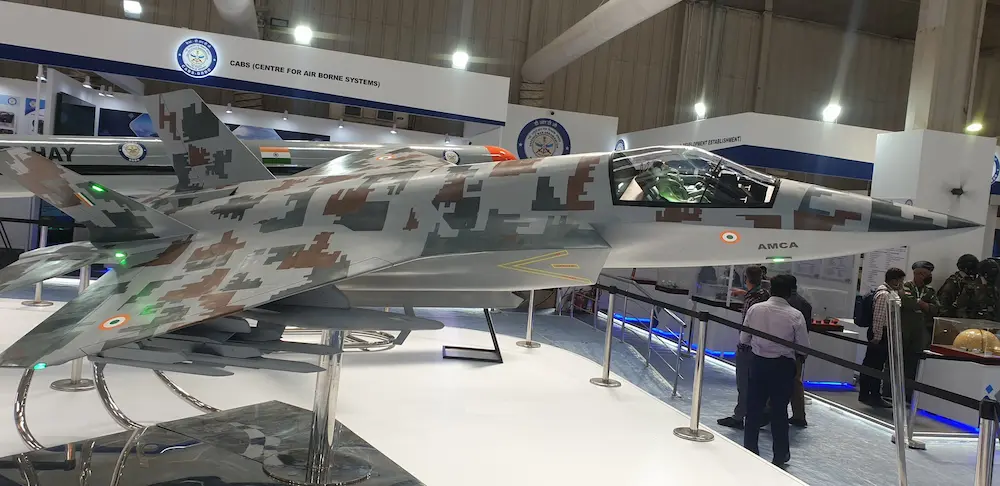
The Advanced Medium Combat Aircraft (AMCA) is India’s ambitious fifth-generation fighter project (photo-wikipwdia)
Fifth-Generation Air Dominance – India stands at a pivotal juncture in its military aviation journey. With regional adversaries modernizing their fleets and the Indian Air Force (IAF) grappling with squadron shortages, the race to acquire fifth-generation fighter aircraft has intensified. Three contenders dominate the conversation: the American F-35 Lightning II, the Russian Su-57 Felon, and India’s indigenous Advanced Medium Combat Aircraft (AMCA). Each offers distinct advantages, challenges, and strategic implications.
This blog explores the capabilities of these aircraft, India’s current defense ecosystem, and the geopolitical calculus that will shape the nation’s choice.
Why Fifth-Generation Fighters Matter
Fifth-generation fighters are not just faster or stealthier—they represent a paradigm shift in aerial warfare. These jets combine:
- Stealth technology for radar evasion
- Sensor fusion for real-time battlefield awareness
- Supercruise capability (sustained supersonic flight without afterburners)
- Advanced avionics and networking for coordinated operations
- Internal weapons bays to maintain stealth profiles
For India, acquiring such platforms is essential to counter threats from China’s J-20 and J-35, and Pakistan’s expected induction of Chinese stealth fighters.
F-35 Lightning II: Cutting-Edge, But Complicated
The F-35, developed by Lockheed Martin, is arguably the most advanced fifth-generation fighter in service today. It comes in three variants (A, B, and C) and is used by multiple NATO allies.
Key Features
- Stealth profile with low radar cross-section
- Sensor fusion and AI-assisted targeting
- Network-centric warfare capabilities
- Combat-proven in multiple theaters
- Variants for air force, navy, and marines
Pros for India
- Unmatched stealth and situational awareness
- Access to Western defense networks
- Potential deterrence against China
Challenges
- High cost: Over $100 million per unit
- Ecosystem mismatch: India’s fleet is largely Russian-origin
- Limited operational autonomy: US export controls and integration hurdles
- No formal negotiations: India has not initiated a purchase
Despite the buzz, India has reportedly informed the US that it is not interested in acquiring the F-35 at this time.
Su-57 Felon: Familiar Partner, Uncertain Future
Russia’s Su-57 is a twin-engine stealth fighter designed for air superiority and ground attack. India previously partnered with Russia on the FGFA (Fifth Generation Fighter Aircraft) program but withdrew due to concerns over cost and performance.
Key Features
- Supermaneuverability with thrust-vectoring engines
- Internal weapons bays
- Advanced radar and electronic warfare systems
- Potential for technology transfer
Pros for India
- Easier integration with existing Russian platforms (Su-30MKI, S-400)
- Lower cost than F-35
- Offer of co-production and tech transfer
- Strategic autonomy in operations
Challenges
- Limited combat testing
- Sanctions risk due to Russia’s geopolitical isolation
- Delayed production and delivery
- Concerns over stealth effectiveness
Russia has reportedly offered India local production rights and full technology transfer, including the Su-57’s new R-77M missile system, which could outmatch Chinese PL-15 missiles.
AMCA: India’s Indigenous Leap into Stealth
The Advanced Medium Combat Aircraft (AMCA) is India’s ambitious fifth-generation fighter project, led by the Aeronautical Development Agency (ADA) and DRDO. It aims to deliver a twin-engine, stealth multirole fighter tailored to India’s strategic needs.
Key Features
- Stealth design with internal weapons bays
- Supercruise capability
- AI-powered avionics and sensor fusion
- Net-centric warfare systems
- Indigenous engine development underway
Pros for India
- Strategic autonomy and self-reliance
- Custom-built for Indian terrain and doctrine
- Boost to domestic defense industry
- Lower long-term costs
Challenges
- Prototype not expected before 2027–28
- Operational induction likely post-2036
- Engine development hurdles
- Funding and timeline risks
India has signed agreements with GE Aerospace for engine production and is developing the Kaveri 2.0 engine for future variants. The AMCA is seen as a symbol of Atmanirbharta (self-reliance) in defense.
Strategic Considerations
India’s decision isn’t just about specs—it’s about geopolitics, logistics, and long-term vision.
| Factor | F-35 | Su-57 | AMCA |
|---|---|---|---|
| Stealth | ✅ | ⚠️ | ✅ |
| Combat Proven | ✅ | ⚠️ | ❌ |
| Cost | ❌ | ⚠️ | ✅ |
| Tech Transfer | ❌ | ✅ | ✅ |
| Ecosystem Fit | ❌ | ✅ | ✅ |
| Operational Autonomy | ❌ | ✅ | ✅ |
| Timeline | ✅ | ⚠️ | ❌ |
| Strategic Independence | ❌ | ⚠️ | ✅ |
The Verdict: A Multi-Track Strategy?
India may not choose just one. A hybrid approach could include:
- Short-term imports of Su-57s to fill capability gaps
- Continued investment in AMCA for long-term autonomy
- Selective upgrades to existing platforms (Su-30MKI, Rafale)
- Strategic partnerships for engine and avionics development
This strategy balances immediate needs with future aspirations, while avoiding overdependence on any single country.
Fifth-Generation Air Dominance : Flying Toward Sovereignty
India’s fifth-generation fighter decision is more than a procurement, it’s a declaration of intent. Whether it’s the proven might of the F-35, the familiar promise of the Su-57, or the bold ambition of the AMCA, the choice will shape India’s air power for decades.
In the skies of tomorrow, India must not only fly higher but fly smarter, faster, and on its own terms.
Also read – AMCA Program Under Siege: HAL Monopoly Stifles Innovation and Progress
India’s AMCA: The Future of 5th-Generation Fighter Aircraft
India’s Strategic Rebuff: Declining the F-35 Deal in a Shifting Global Chessboard